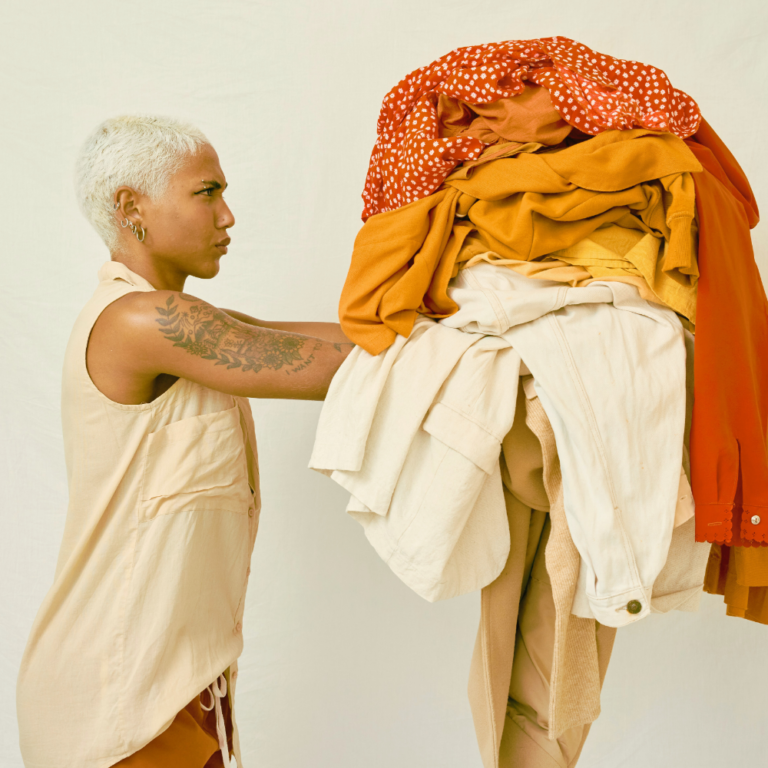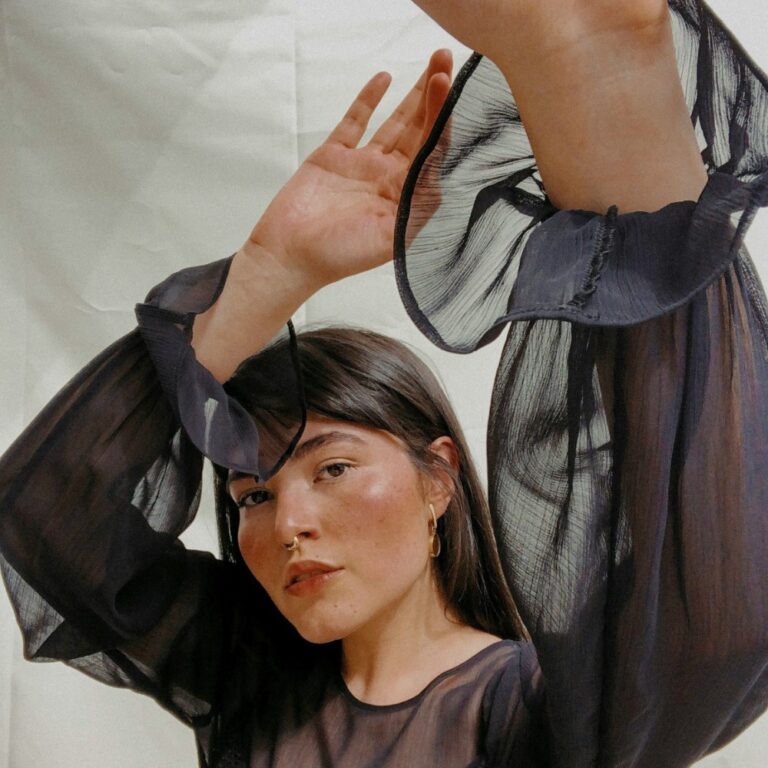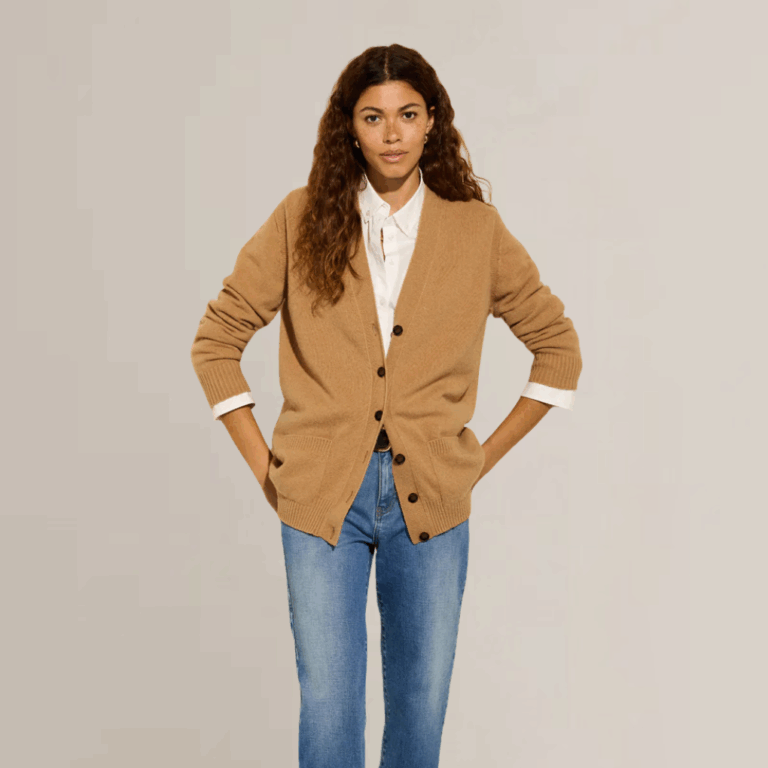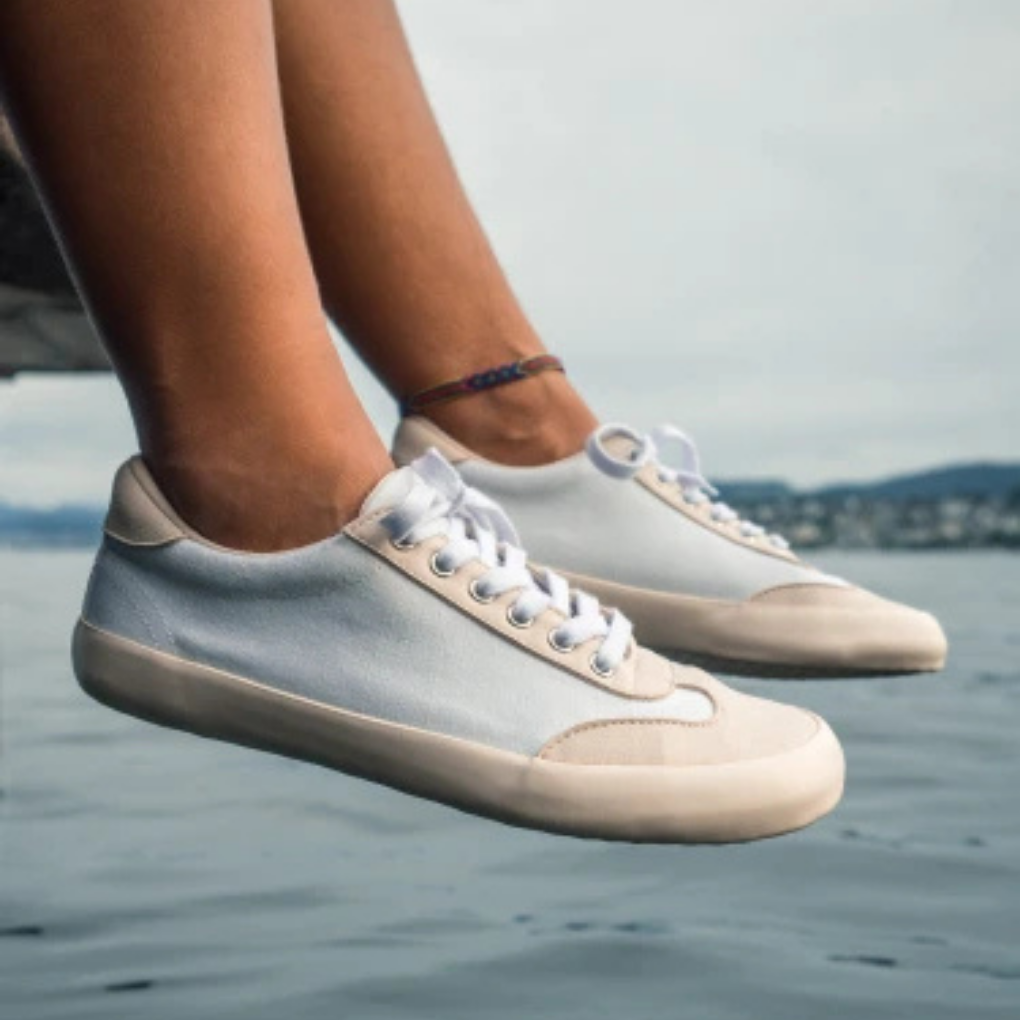
Key Takeaways
- The best barefoot shoes support natural foot movement and healthier posture.
- Top brands balance comfort, durability, and minimalist design.
- Choosing barefoot shoes can improve balance, mobility, and long-term foot health.
I used to think the best barefoot shoes were only those funky ones with the separate toe “fingers” — you know, the ones that look like gloves for your feet. But barefoot shoes actually come in all kinds of styles, from sleek everyday sneakers to trail-ready boots, all designed to help your feet move the way nature intended.
Walking the way nature intended is making a comeback. Barefoot shoes mimic the feeling of being barefoot while still giving your feet protection, and people love them for good reason. They encourage natural movement, strengthen foot and leg muscles, and may even help reduce common aches caused by traditional cushioned shoes.
In this guide, we’ll break down the best barefoot shoes available today, what makes them stand out, and how to choose a pair that fits your lifestyle.
Best Barefoot Shoes: What Makes Them Different?
The best barefoot shoes stand out because they flip traditional shoe design on its head. Instead of padding your feet with layers of foam and arch support, they strip things down to the essentials:
- Thin, flexible sole – lets you sense the ground beneath you.
- Wide toe box – gives your toes space to spread and move naturally.
- Zero drop – keeps your heel and forefoot level, supporting better posture.
- Lightweight build – makes every step feel less restricted.
This minimalist design allows your feet to move as nature intended. Many people find that switching to barefoot shoes helps improve balance, strengthen foot and leg muscles, and even ease everyday aches linked to conventional footwear.
Far from being a niche trend, barefoot shoes now come in sneakers, boots, sandals, and even office-appropriate styles — proving that function and fashion can go hand in hand.
Benefits of Barefoot Shoes
Barefoot shoes aren’t just a trend — they represent a shift toward healthier, more natural movement. When designed well, they offer a wide range of benefits:
Natural Gait & Posture Alignment
Most modern shoes raise the heel, squeeze the toes, and add layers of cushioning. Over time, this changes how your body moves. Barefoot shoes eliminate those barriers, encouraging a midfoot strike and upright posture. This can reduce stress on your knees, hips, and lower back, while making walking and running feel more fluid.
Stronger Feet, Ankles & Lower Legs
When cushioning and arch support are removed, the muscles, tendons, and ligaments in your feet actually have to work. The best barefoot shoes act like strength training for your feet — helping build stronger arches, more stable ankles, and improved resilience against injuries like sprains.
Better Balance & Proprioception
The thin sole of barefoot shoes allows you to sense subtle changes in the ground, a concept known as proprioception. This “ground feel” improves balance and agility, which can make a real difference whether you’re trail running, practicing yoga, or simply carrying groceries across a slippery driveway.
Relief From Common Foot Pain
Many people turn to barefoot shoes after struggling with issues like plantar fasciitis, bunions, or shin splints. By giving the toes more space and restoring natural movement patterns, barefoot shoes may reduce pressure points and chronic discomfort. While they’re not a guaranteed cure, they can provide relief for people who feel restricted in traditional footwear.
Versatility Across Activities
From casual sneakers for daily wear to rugged boots for hiking, barefoot shoes now cover a wide range of lifestyles. That means you don’t have to swap comfort for performance — you can find barefoot options for work, workouts, and weekends.
A More Sustainable Choice
Many barefoot shoe brands emphasize eco-friendly materials like natural rubber, cork, or recycled fabrics. Combined with their long-lasting, minimalist construction, they often generate less waste compared to fast-fashion footwear that wears out quickly.
✨ Tip
Transition Gradually
Begin by wearing barefoot shoes for an hour a day, gradually increasing the time as needed. This gives your muscles time to adapt and helps avoid soreness or injury.
How to Choose the Best Barefoot Shoes
Not all barefoot shoes are created equal. The right pair for you depends on how you plan to use them, what materials you prefer, and how they fit your feet. Here’s what to look for before buying:
1. Fit & Sizing Guidance
Barefoot shoes should fit differently than traditional sneakers. Instead of a snug, cushioned feel, you’re aiming for space and flexibility:
- Toe room – your toes should be able to spread without touching the sides.
- Snug heel – the back of the shoe should hold gently without slipping.
- Natural length – leave a thumb’s width of space in front of the longest toe.
2. Activity-Based Recommendations
Think about where and how you’ll wear them:
- Everyday wear → Look for versatile sneakers or casual styles with durable outsoles.
- Running or training → Choose models with extra grip and breathable uppers.
- Hiking or outdoors → Prioritize traction, weather resistance, and thicker but still flexible soles.
- Work or dress settings → Some barefoot shoes now come in leather or minimalist dress designs that still meet office standards.
3. Materials & Sustainability
Materials matter both for comfort and environmental impact. Common options include:
- Natural rubber soles – flexible and durable.
- Leather or cork – breathable and long-lasting.
- Recycled synthetics – lighter footprint compared to virgin plastics.
Choosing brands that focus on eco-friendly materials can extend the benefits of barefoot shoes beyond foot health — supporting a lower-plastic lifestyle, too.
Don’t Miss: Greenwashing in Fashion Curious if those “eco-friendly” barefoot shoes are truly sustainable? Learn how to spot greenwashing before you buy. Read more →4. Budget Considerations
Barefoot shoes range from $50 budget-friendly pairs to $200+ premium models. If you’re new, start with an affordable option to see how your feet adapt. If you fall in love with the style, investing in higher-quality pairs makes sense for long-term durability.
Comparison and Alternatives: Barefoot Shoes vs. Traditional Footwear
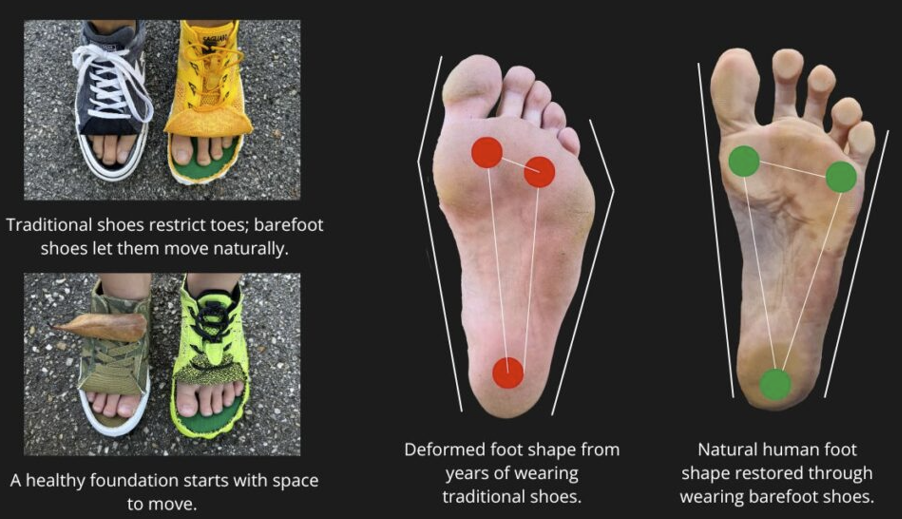
If you’re new to barefoot shoes, you might wonder how they compare to your regular sneakers or everyday shoes. One big difference is in the fit: barefoot shoes usually have a wider toe box, letting your toes spread out naturally instead of being squeezed together like in traditional shoes such as Adidas Sambas or Vans. This wide toe box encourages better toe splay and reduces that uncomfortable toe scrunch feeling.
Traditional sneakers often have thick, cushioned soles and elevated heels, while barefoot shoes like the Xero Shoes 360 or Vibram FiveFingers Vapor Glove feature zero-drop soles that keep your feet flat and close to the ground. This helps promote more natural foot movement and posture.
There are also plenty of barefoot sneaker alternatives if you want something stylish but still barefoot-friendly. Brands like Ohne Project, BLSN-200W, and Brambas offer minimalist designs with eco-friendly materials and flexible soles. For runners, models like the Primus Lite Knit or Tyr DropZero combine lightweight support with barefoot benefits.
Whether you’re looking for casual shoes or something for workouts, the barefoot shoe world has lots of options that give you freedom and comfort while supporting healthy foot mechanics.
Why Sustainability in Barefoot Shoes Matters
Most shoes out there are packed with plastic and other synthetic materials that aren’t great for the planet. Think polyester, EVA foam, and polyurethane; they don’t break down easily and often end up piling in landfills or polluting our oceans. Plus, making shoes usually takes a ton of water, energy, and sometimes involves chemicals that aren’t exactly eco-friendly.
That’s where sustainable barefoot shoes come in. These brands focus on using natural or recycled materials like organic cotton, hemp, cork, and natural rubber instead of plastic-heavy stuff. Not only does that help reduce plastic waste, but it also cuts down on the carbon footprint of each pair.
But it’s not just about materials. Many sustainable barefoot shoe companies also care about how their shoes are made, making sure workers are treated fairly, producing in small batches to avoid waste, and using packaging that’s kind to the environment. Certifications like B Corp and Fair Trade help you spot brands that walk the talk.
So, when you choose sustainable barefoot shoes, you’re not just doing something good for your feet; you’re helping the planet too. It’s a win-win that’s worth stepping into. (pun intended)
6 Best Barefoot Shoe Brands That Are Sustainable
To make choosing easier, we’ve rated each brand across the features that matter most — from flexibility and traction to durability and overall value. This way, you can see at a glance which barefoot shoes best fit your lifestyle and priorities.
How We Rated Each Brand
Our ratings combine brand specs, customer feedback, and real-world use. We looked at:
- Flexibility & Sole Thickness – how natural the shoe feels.
- Toe Box Width – space for natural toe spread.
- Traction & Stability – grip and support on different surfaces.
- Durability – quality of materials and construction.
- Value – price compared to performance and sustainability.
We kept the scores simple (e.g., Excellent, Good, ★★★★☆) so you can compare brands at a glance.
| Brand | Best For | Sole Thickness / Flexibility | Toe Box Width | Traction | Stability | Durability | Value |
|---|---|---|---|---|---|---|---|
| Wildling | Eco-conscious everyday wear | Thin / Very Flexible | Wide | Urban / Trail | Moderate | Good |
★★★★☆ ($100–$160) |
| Vivobarefoot | All-around performance | Thin / Flexible | Wide | Trail / General | High | Excellent |
★★★★☆ ($86–$220) |
| Groundies | Stylish urban wear | Thin / Flexible | Medium–Wide | Urban | Moderate | Good |
★★★☆☆ ($100–$149) |
| Patara | Casual lifestyle | Thin / Moderate Flex | Medium | Urban | Low–Moderate | Moderate |
★★★☆☆ ($115–$165) |
| Bohempia | Vegan & sustainable | Thin / Flexible | Wide | Urban | Moderate | Good |
★★★☆☆ ($96–$150) |
| Ahinsa | Orthopedic-friendly | Thin / Flexible | Wide–Extra Wide | Urban / General | High | Excellent |
★★★★☆ ($115–$278) |
Use this chart as a quick decision guide:
- If you need extra toe room, look for Wide–Extra Wide models.
- For trail or outdoor use, prioritize high traction and durability.
- If budget is your main concern, focus on brands with higher value scores.
Wildling Shoes
$100-160
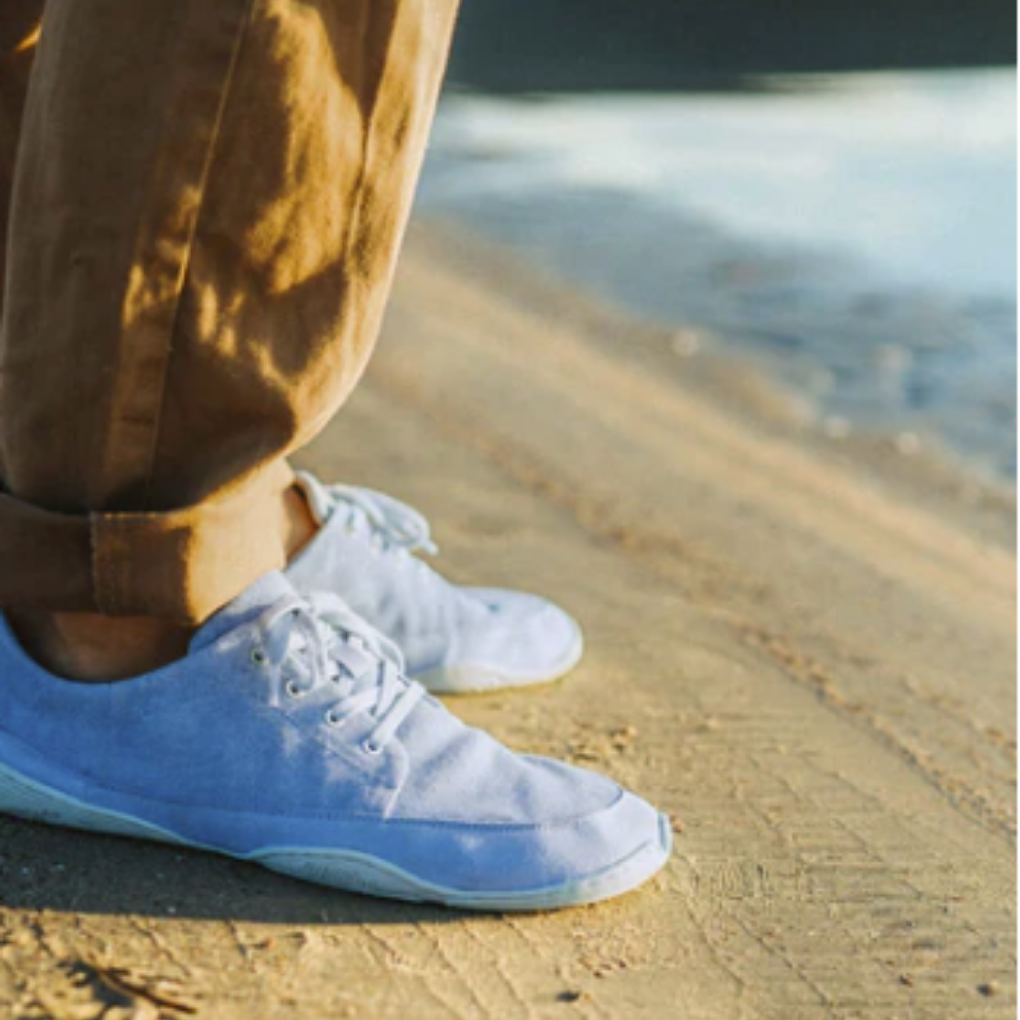
Founded in 2015 by Anna and Ran Yona, Wildling Shoes is a German barefoot footwear brand focused on creating shoes that support natural foot movement while minimizing environmental impact.
As a certified B Corporation, Wildling is committed to transparency, ethical manufacturing, and sustainable materials.
They prioritize small-batch production in Portugal with fair labor practices and work closely with suppliers to ensure an eco-friendly supply chain.
Why We Love Them
- Certified B Corporation since 2020, reflecting rigorous social and environmental standards
- Uses natural, primarily recycled materials
- Small-batch and repair-friendly production reduces waste and extends product life
- Highly rated by Good On You for sustainability and ethical labor practices
- Material: Organic cotton, hemp, linen, wool uppers; natural rubber soles; some recycled components
- Certifications: B Corporation
Vivobarefoot
$86-220

Founded in 2012 by cousins Galahad and Asher Clark, Vivobarefoot is a British footwear brand dedicated to creating minimalist shoes that promote natural movement.
Their design philosophy emphasizes wide toe boxes, thin soles, and flexible structures, aiming to reconnect people with the natural world through their footwear.
Why We Love Them
- Certified B Corporation since 2020, with a score of 98.8, reflecting high standards of social and environmental performance.
- Launched the ReVivo program to refurbish and resell pre-loved shoes, reducing waste and extending product life.
- Developed the world’s first 3D-printed, compostable shoe in collaboration with Balena, utilizing BioCir®flex material that is over 51% bio-based and certified to break down in industrial composting within 90 days.
- Incorporates BLOOM® foam made from algae biomass in some models, contributing to environmental conservation by recycling water and reducing carbon dioxide.
- Material: Natural and recycled materials including Merino wool, Tencel® (eucalyptus fiber), natural and recycled rubber soles, and recycled polyurethane foam insoles. Some models also use BLOOM® foam made from algae biomass.
- Certifications: B Corporation, Vegan Society certification
Groundies
$100-149
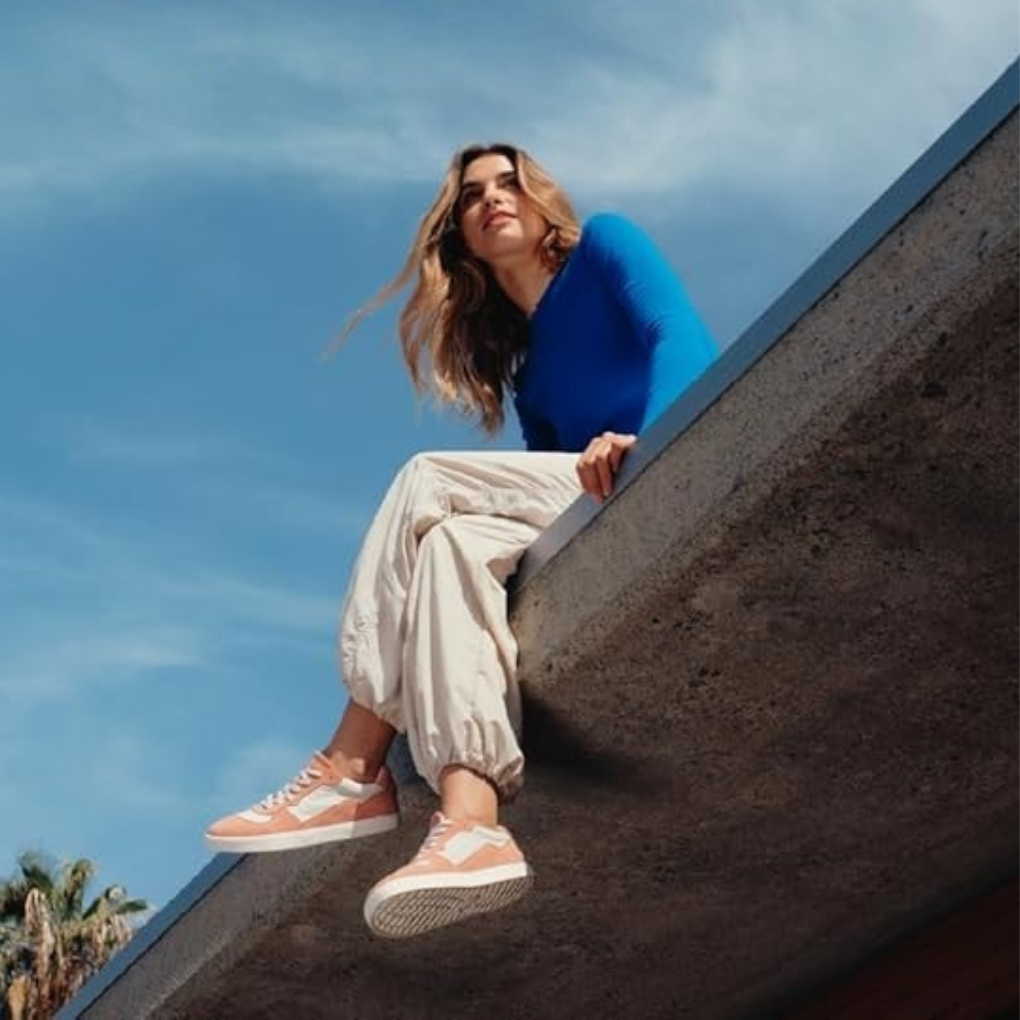
Groundies is a German brand specializing in barefoot shoes that combine minimalist design with urban style. Their footwear is crafted to support natural foot movement while maintaining a fashionable appearance.
Groundies emphasizes sustainable practices in their production process, partnering with skilled producers in Portugal and Vietnam to ensure high-quality craftsmanship under fair working conditions.
Why We Love Them
- Vegan Options: Groundies offers a range of vegan barefoot shoes made from materials like recycled cotton and Vegea, a high-tech, plant-based material derived from grape pomace oils and lignocellulose.
- Climate Neutral: The brand has been certified as Climate Neutral since 2020, reflecting its commitment to reducing carbon emissions.
- Ethical Production: Groundies ensures their shoes are produced under fair working conditions, with a focus on sustainable quality and craftsmanship.
- Material: Vegan microfiber, recycled cotton, Vegea (plant-based leather alternative), and recycled rubber soles.
- Certifications: Climate Neutral
Patara
$115-165
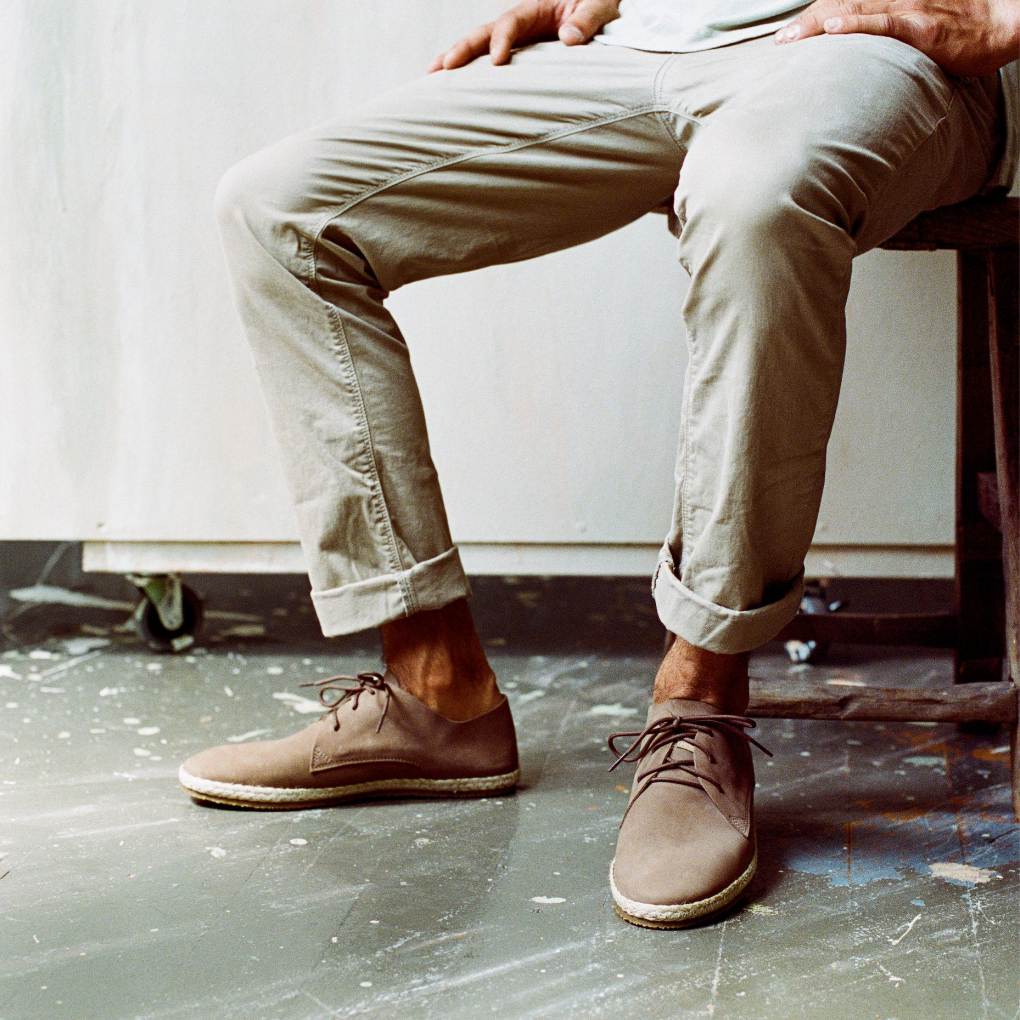
Patara is a San Diego-based footwear brand founded by brothers Christian and Kilian.
Inspired by their travels through Southeast Asia, they sought to create a versatile shoe that could seamlessly transition from day to night.
Their designs highlight minimalist style, comfort, and sustainability, all while delivering a barefoot-like feel without compromising on fashion.
Why We Love Them
- Certified B Corporation: Patara is a Certified B Corporation, meeting high standards of social and environmental performance, accountability, and transparency.
- Sustainable Materials: Their shoes are crafted using eco-friendly materials such as hemp, cork, organic cotton, recycled PET, and natural rubber.
- Ethical Production: Patara’s footwear is handcrafted in ethical factories that uphold fair wages, safe working conditions, and responsible manufacturing practices.
- Vegan-Friendly Options: Many of their designs are certified vegan and constructed without any animal-derived materials.
- Material: Handwoven cotton, GRS-certified recycled polyester laces, natural cork insoles with bio-based sunflower and soybean oils, recycled foam, and natural rubber outsoles.
- Certifications: GRS-certified recycled cotton and polyester, OEKO-TEX® Standard 100 certified dyes, and Certified B Corporation status.
Bohempia
$96-150

Founded in 2015 by Czech entrepreneur Tomáš Rohal, Bohempia emerged from a vision to create sustainable, vegan footwear that promotes natural movement.
The company is based in Prague and collaborates with family-owned workshops across the European Union to produce its shoes.
Their mission centers on bringing hemp back into mainstream use, emphasizing environmental and social sustainability in fashion.
Why We Love Them
- Sustainable Materials: Crafted from 100% hemp canvas, natural rubber outsoles, and recycled PET vegan suede, Bohempia prioritizes eco-friendly materials throughout their products.
- Ethical Production: Handmade in the EU, Bohempia ensures fair labor practices and high-quality craftsmanship in every pair.
- Vegan Certified: All Bohempia footwear is PETA-approved vegan, containing no animal-derived materials.
- Stylish & Versatile: Their minimalist designs, such as the Kolda and Herlik models, offer both comfort and style suitable for various occasions.
- Transparency & Accountability: Bohempia is committed to openness about their production processes and environmental impact.
- Material: 100% hemp canvas upper, natural rubber outsole, recycled PET vegan suede, cotton laces.
- Certifications: PETA-Approved Vegan
Ahinsa
$115–278

Ahinsa is a Czech brand founded by physiotherapist Lukáš Klimpera, who combined his expertise with a passion for natural movement to create footwear that supports foot health and overall well-being.
Their shoes are handcrafted in Slovakia and Croatia, using 100% vegan materials sourced from Europe.
Designed with both functionality and style in mind, Ahinsa shoes aim to provide a barefoot-like experience without compromising on aesthetics.
Why We Love Them
- Designed by Physiotherapists: Each pair is crafted with foot health in mind, ensuring proper alignment and comfort.
- Ethically Made: Handmade in Europe using sustainable, vegan materials.
- Durability Guaranteed: Many models come with a 3-year warranty, reflecting their commitment to quality.
- Flexible and Lightweight: Shoes are designed to bend with your foot, offering flexibility and a natural stride.
- Breathable and Waterproof Options: Some models feature innovative materials like CF+ Ultradry for moisture control.
- Material: 100% vegan materials including Mabel (apple waste vegan leather), Malai (biodegradable coconut-based material), hemp, linen, cotton, recycled PET, natural cork, and CF UltraDry corn polymer linings.
- Certifications: No formal 3rd party certifications. All materials are sourced from EU countries with strict health and safety certifications.
Why People Are Making the Switch to Barefoot Shoes
Let’s break down how barefoot shoes stack up against traditional footwear — the pros, the cons, and why so many people are making the switch.
Why People Are Making the Switch to Barefoot Shoes
| Type | Pros | Cons |
|---|---|---|
| Barefoot Shoes |
|
|
| Traditional Shoes |
|
|
The Verdict: Once you adjust, barefoot shoes often improve balance, foot strength, and overall comfort. Traditional shoes offer more protection but may compromise natural movement. The best choice depends on your lifestyle and goals.
Best Barefoot Shoes for Every Activity
Finding the right barefoot shoes isn’t just about style; it’s about matching the shoe to what you actually do most. Whether you’re lifting heavy in the gym, running trails, powering through HIIT workouts, or just strolling around town, the right pair can make all the difference. Below, we break down which barefoot shoes work best for different activities so that you can pick the perfect fit for your lifestyle.
🏋️Lifting & Strength Training
Barefoot shoes give you great ground feel and stability with their flat, zero-drop soles and wide toe boxes. This helps your feet grip the floor naturally, improving balance for exercises like deadlifts and squats. Some even offer extra ankle support if you need it.
🏃Running
Look for barefoot shoes with durable soles and good traction for trails or pavement. The thin, flexible soles help you connect with the ground and improve your running form. Waterproof or quick-drying models are perfect for wet or muddy runs.
🤸HIIT & CrossFit
You’ll want shoes that handle quick direction changes and provide a solid grip without losing flexibility. Barefoot cross-training shoes balance agility and stability, so you can move fast and stay secure.
👟Casual Wear & Walking
Barefoot shoes offer all-day comfort with breathable materials and plenty of toe room. They’re lightweight and stylish enough for everyday wear while supporting healthy feet.
No matter your activity, choosing barefoot shoes that suit your needs, whether it’s ground feel, traction, ankle support, or simple comfort, is key.
How to Choose Your Perfect Sustainable Barefoot Shoe
Picking the right barefoot shoe can feel a bit tricky at first, after all, these aren’t your typical sneakers! But once you get the hang of it, you’ll appreciate how much better they feel for your feet and the planet.
- Fit is everything. Barefoot shoes usually have a wide toe box to let your toes spread out naturally. That’s a massive plus for comfort and foot health. When you try them on, make sure there’s enough room for your toes to wiggle without feeling cramped. Sizing can vary between brands, so it’s a good idea to check each company’s size guide or read reviews to see if you should size up or down.
- Think about materials based on your lifestyle. If you’re vegan or prefer animal-free options, look for brands that use plant-based or recycled materials like hemp, organic cotton, or recycled plastics. If biodegradability is a priority, natural fabrics and leathers that break down more easily in the environment might be your best bet.
- What will you use them for? Barefoot shoes aren’t just for everyday walking. There are options built specifically for running, hiking, or casual wear. For example, if you’re after the best sustainable shoes for running, look for models with extra sole durability but still keep that barefoot feel. For hiking, you might want something with better grip but still flexible.
Shoe Fit and Sizing Guidance
Getting the right fit with barefoot shoes is just as important as choosing the right style. Since these shoes are designed to let your feet move naturally, the fit should feel different from traditional footwear.
- Toe Box: Look for a wide, foot-shaped toe box that lets your toes spread out fully when standing and walking. Your toes shouldn’t feel squished from the sides or the top.
- Length: Most barefoot shoes should have a small amount of extra space (about a thumb’s width) in front of your longest toe to allow natural movement and toe splay.
- Width and Foot Shape: Some brands run narrower or wider than others. If you have wide feet, high arches, or higher foot volume, check the brand’s size chart and customer reviews. Many brands also offer “wide” versions or have a fit quiz on their site.
- Insoles and Adjustments: Barefoot shoes often have thin, removable insoles. Removing them can give you more space or improve ground feel. Adding a thin insole can make the fit snugger if needed.
- Ankle and Heel Fit: Your heel should stay secure without slipping, and the shoe should feel comfortable around the ankle. Avoid tight spots that rub, especially if you’ll be using them for long walks or workouts.
- Brand Sizing Differences: Sizing can vary a lot between brands and even between models. Always check each brand’s size chart, look for relative sizing notes, and when in doubt, order two sizes to compare at home.
A barefoot shoe should feel like an extension of your foot — secure at the heel and midfoot, roomy in the toes, and flexible enough to let your foot move naturally.
tips
Care & Maintenance for Barefoot Shoes
Taking good care of your sustainable barefoot shoes not only keeps them looking fresh but also helps them last longer, which is excellent for your wallet and the planet!
- Cleaning Made Simple: Most barefoot shoes made from natural or recycled materials can be gently cleaned with a soft brush or cloth. For tougher spots, use mild soap and lukewarm water, and skip harsh chemicals that can damage eco-friendly fabrics. Always air dry your shoes away from direct heat or sunlight to avoid warping or fading.
- Repair, Don’t Replace: Many sustainable shoe brands offer repair services or provide replacement parts like insoles or laces. Fixing minor issues like worn soles or loose stitching keeps shoes in use longer, reducing waste and supporting a circular economy. Plus, repairing your favorite pair can be surprisingly easy and satisfying!
- Store Smart: When you’re not wearing your shoes, keep them in a cool, dry place. Avoid cramming them in tight spots or stacking heavy items on top, which can deform the shape. Using a shoe tree or stuffing shoes with recycled paper helps maintain their structure and prevents creases.
Budget and Value Options
Barefoot shoes don’t have to blow your budget. There are plenty of affordable choices that still deliver comfort, a natural fit, and healthy foot movement. Many budget-friendly styles are made with durable, eco-conscious materials like recycled fabrics, vegan synthetics, or even creative picks like corn leather. Some are machine washable, making them super easy to keep fresh.
Even without the high-end price tag, you can still get the essentials: wide toe box, zero-drop sole, and flexible construction that lets your feet move naturally. By watching for seasonal sales or discount codes, you can snag great deals without sacrificing quality.
Budget picks are perfect if you’re new to barefoot shoes or want an extra pair for specific activities without spending big. You’ll still get that close-to-the-ground, barefoot experience—just with more money left in your wallet.
Donate Your Shoes & Support Nonprofit Organizations
One great way to extend the life of your barefoot or sustainable shoes is by donating them when you’re ready to move on. Instead of throwing shoes away, donating helps reduce waste and supports people in need around the world.
Several nonprofit organizations specialize in collecting gently used shoes and distributing them to communities facing economic hardships or natural disasters. Some well-known nonprofits that accept shoe donations include:

- Soles4Souls: I’ve personally donated to Soles4Souls and can’t recommend them enough. They do incredible work collecting shoes from all over the world and getting them into the hands of those who need them most, while also supporting sustainable job creation.
- Planet Aid: Focuses on environmental sustainability by collecting used clothing and shoes, then reselling or donating them to fund development programs.
- Give Back Box: You can donate gently used shoes through Give Back Box by selecting a specific charity, such as Shoes for the Homeless, Sharing Shoes, or Ukrainian Refugee support, for example. Just print a shipping label, pack your box, and send it off—some labels are free, while others may require a small fee to route your donation directly.
Before donating, be sure to check each organization’s guidelines to ensure your barefoot or sustainable shoes meet their criteria. Donating your shoes is a meaningful way to support sustainability and make a positive impact beyond your lifestyle.
Don’t Miss: Microplastics: Health Risks, Sources, and How to Reduce Exposure Ever wonder how the materials in our shoes might shed tiny plastics into the environment? Learn what’s at stake and how to reduce your exposure. Read more →FAQs About Barefoot Shoes
Barefoot shoes are designed with a thin, flexible sole and a wide toe box to let your feet move naturally. Unlike traditional shoes with thick cushioning and raised heels, barefoot shoes encourage a more natural gait and posture.
Yes, but it depends on your comfort and experience. Once your feet adjust, many people find barefoot shoes comfortable for daily walking and even long hikes. The key is to transition gradually to build strength and avoid soreness.
Some people report relief from issues like plantar fasciitis, bunions, and lower back pain after switching to barefoot shoes. While they’re not a medical cure, they may reduce stress on joints and improve alignment through natural movement.
Fit is different from regular shoes. Look for a snug heel, room for toes to spread, and about a thumb’s width of space in front of your longest toe. Always check brand-specific sizing charts, as some run larger or smaller than standard sneakers.
Clean gently with mild soap and water, air-dry away from direct heat, and use natural waterproofing sprays to protect fabrics. Replace insoles as needed, and donate or recycle worn-out shoes to keep them out of landfills.
Final Thoughts on Best Barefoot Shoes
Barefoot shoes aren’t just a footwear trend; they’re a way to reconnect with natural movement while making more thoughtful, sustainable choices. From versatile sneakers to eco-conscious hemp and cork designs, today’s barefoot brands prove you don’t have to sacrifice comfort or style to do what’s best for your feet and the planet.
By choosing well-made barefoot shoes and caring for them properly, you’re taking a step toward healthier feet and a healthier planet.
📚References
- Warne, J. P., & Gruber, A. H. (2017). Transitioning to minimalist shoe running: A systematic review of injury, performance, and biomechanical outcomes. British Journal of Sports Medicine, 51(2), 154–160. https://doi.org/10.1136/bjsports-2015-095054
- Rothschild, C. E. (2012). Primitive running: A survey analysis of runners’ interest, participation, and implementation. Journal of Strength and Conditioning Research, 26(8), 2021–2026. https://doi.org/10.1519/JSC.0b013e31823a3c54

